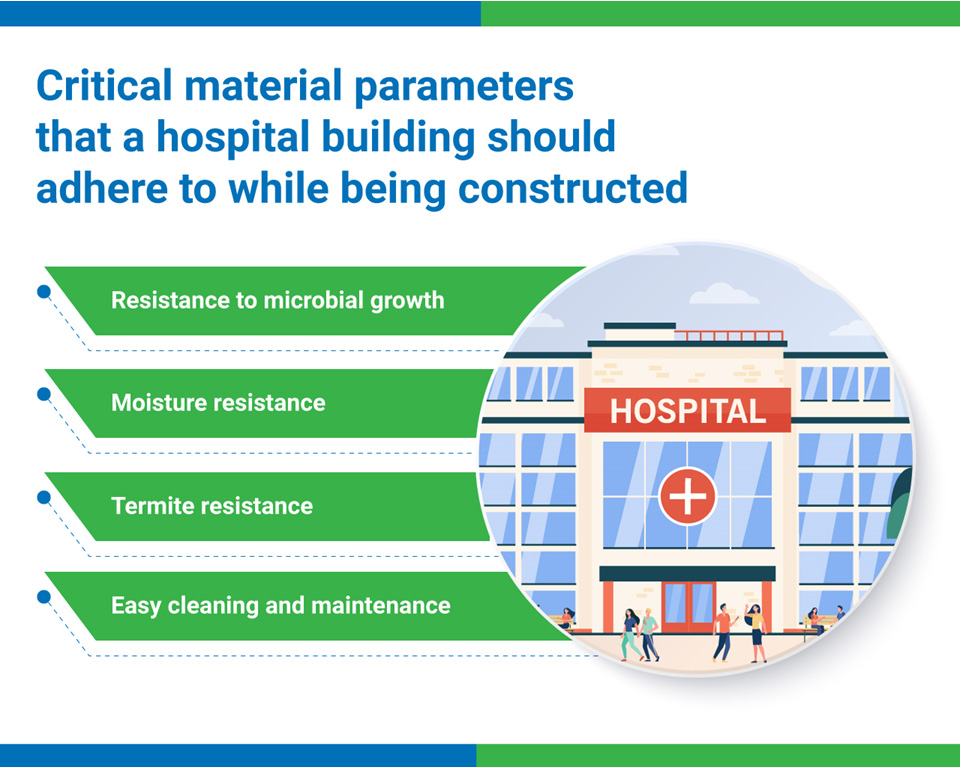
- Homeowners
- Professionals
- Products
- Back
- PlasterBoards
- Metal Framing & Accessories
- Jointing and Finishing
- Gypsum Plasters
- Ceiling Tiles
By material Type
By Category
- Resources
- About
- Careers
- FAQ's
The Covid-19 pandemic facilitated a spike in focus towards hygiene and health safety of individuals. There is now a larger acceptance of measures that put health first such as sanitization, regular health checkups, and overall hygiene. The greater awareness around health has also bought forth the need for reliable Healthcare infrastructure with the emphasis on fast construction of healthcare buildings, increased attention towards indoor hygiene, increased availability and surface maintenance, touch-free solutions, temporary and permanent structures. etc.
Designing a comfortable healthcare infrastructure that is essentially a healing space requires an understanding of the inherent requirements in the healthcare sector. Health and Hygiene in a way happen to be one of the top priorities while designing healthcare buildings.
A healthy healing space
A Healthy hospital is defined by the quality of air in the indoor environment. Indoor air quality includes the physical, chemical and biological characteristics of air in the indoor environment. Good Indoor Air Quality in hospitals ensures benefits for both patients and staff



For any building, it is discovered that indoor air is 10 times more polluted than outdoor air. The bad air can slow down a patient’s healing. Out of all the indoor pollutants, formaldehyde – one of the most dangerous VOCs is a big threat not only to your patients but also to your staff. It is one of the reasons that causes sneezing, coughing, headaches, fatigue, eye, and skin irritations. It is a potent, colourless gas that is commonly used in hospitals in medical laboratories, dental offices, and pediatric practices as a preservative, sterilizer, and disinfectant. It is also used for manufacturing purposes and funeral homes for embalming.
Since it is used for many applications, it is bound to be omnipresent in the air indoor, thus making it polluted and harmful for individuals. Even when the ventilation systems are installed, it is still possible to have a room with a significant concentration of formaldehyde. But there is a solution to reduce these harmful formaldehyde levels in hospital buildings, through a much surprising method - THE CEILING AND THE WALLS.
Saint Gobain Gyproc Has introduced ActivAir® boards which when used in sufficient wall and ceiling surface coverage can reduce formaldehyde up to 70%. It can absorb formaldehyde and convert them to a harmless inert compound. The result – A MUCH CLEANER AIR. All this while the walls and ceiling continue to perform their designated task.
Healthy hospital designs need to incorporate solutions that help reduce harmful indoor air pollutants. This could be achieved by adopting building materials that help maintain good indoor air quality. Gyproc offers ActivAir® technology through Gypsum boards for walls and ceilings and also through perforated Gypsum boards – Rigitone, that can be a perfect blend of visual appeal and superior sound absorption to promote optimum ambient sound in any room.

Hygiene is defined as the conditions or practices conducive to maintaining health and preventing diseases. Maintenance of hygiene and cleanliness in healthcare facilities reduces the incidence of Hospital-acquired infections. A very important aspect of hospital interiors that is overlooked usually, are wet areas. Wet areas, including bathrooms, toilets etc, need to be robust as they are commonly used areas. Hygiene in wet areas thus becomes critical with respect to providing a safer environment that can prevent infections.
To cater to these requirements, Gyproc offers a wide range of solutions.
Glasroc H is new generation plasterboard for ceilings & drywall applications in Healthcare. Manufactured with eGRG (Enhanced Glass Reinforced Gypsum) technology with glass fibre reinforced gypsum core and encased by special hydrophobic treated glass mat liners, Glasroc H provides excellent water resistance, mould resistance & termite resistance. It also enables tiling of up to 60 kg/m2.
Since maintenance and cleaning are very frequent in healthcare buildings, Gyprex® Polyshield Tiles are best suited for hospital ceiling applications where there is a need for Reducing particulate contamination, moisture resistance and easy cleaning and maintenance. Gyprex Asepta is another special Biocidal PVC Laminated Tile that has anti-bacterial and anti-fungal; properties in addition to Polyshield properties as mentioned earlier.
In requirements where high acoustic absorption is required typically for noisy areas, and where cleanability and maintenance are also equally frequent, is where Saint Gobain Ecophon HygieneTM stands out as a peculiar choice. Its wet cleanable microporous surface makes it a proven performer in hygienic requirements and fulfilling acoustic demands for quieter healthcare spaces. Ecophon Hygiene and the complete system fulfil even the toughest requirements.
Providing universal quality healthcare access to all citizens is the need of the hour. Across the world, the healthcare sector needs many more healing spaces to impart quality healthcare to meet the guidelines defined by the World Health Organization on the number of hospital beds per thousand people. A healing space invokes themes of a healthy neighbourhood, modern care, sustainable development and quality design. Healthcare architecture draws a true line to the purpose of healing. There is now a need more than ever, for new hospitals as per globally recognized standards.
Going forward, both building design and maintenance need to have an even greater focus on safeguarding against infection and contamination. This includes a stronger emphasis on cleaning and disinfecting surfaces that do not allow the propagation of harmful micro-organisms. Hence it is a need of the hour to adopt building materials that are easy to clean and maintain, resists microbial growth and are safe to use.
More Articles